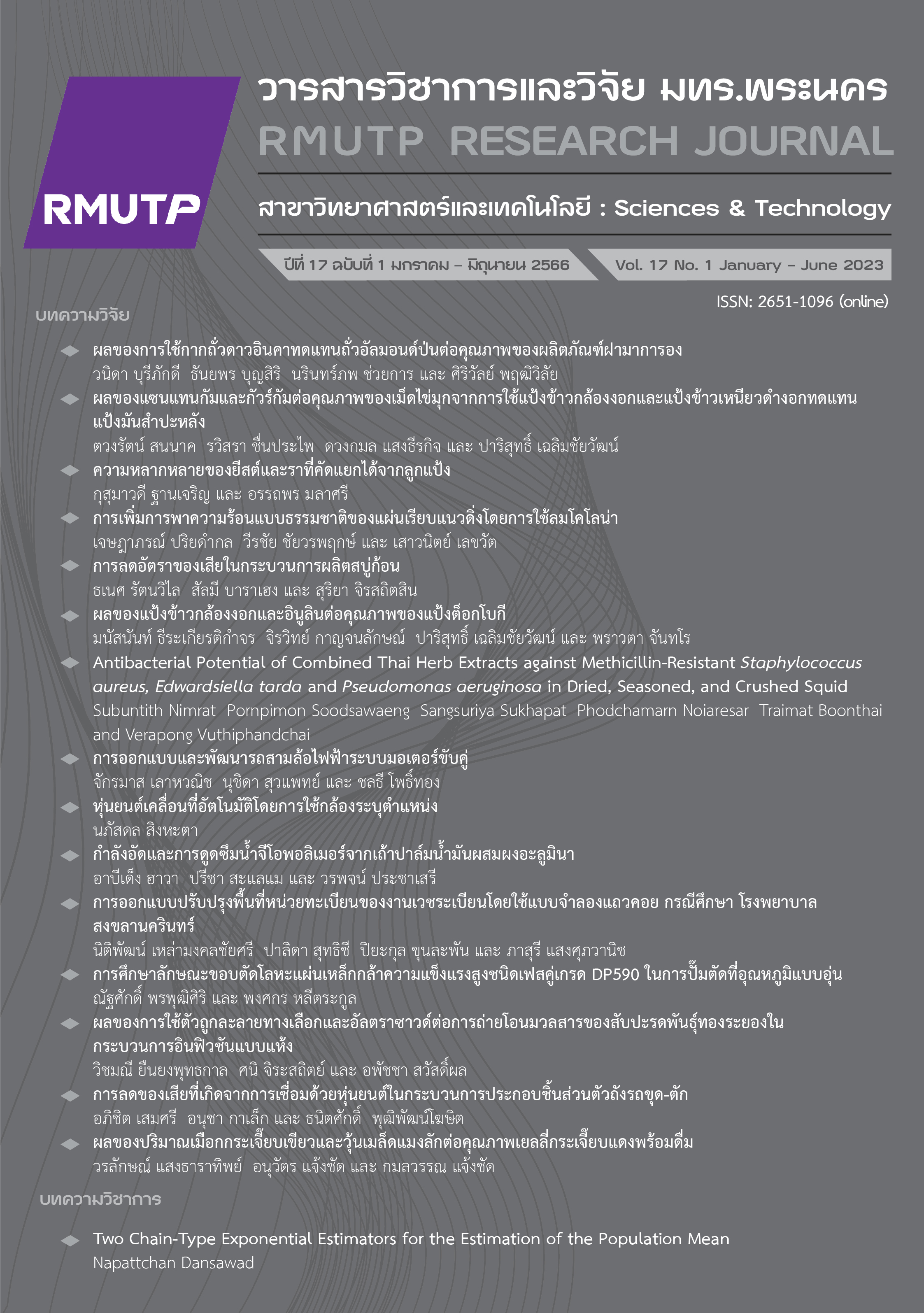หุ่นยนต์เคลื่อนที่อัตโนมัติโดยการใช้กล้องระบุตำแหน่ง
Main Article Content
บทคัดย่อ
บทความนี้นำเสนอการระบุตำแหน่ง ซึ่งเป็นวิธีที่เชื่อถือได้ในการระบุตำแหน่งปัจจุบันของหุ่นยนต์โดยใช้การประมวลผลภาพ ซึ่งสามารถปรับปรุงการหลีกเลี่ยงการชนของสิ่งกีดขวางได้อย่างมีประสิทธิภาพด้วยเซ็นเซอร์ตรวจจับแสงและวัดระยะ (LiDAR) สำหรับหุ่นยนต์เคลื่อนที่อัตโนมัติ หุ่นยนต์พิจารณาห้าประการ ประการแรก เพื่อลดปัญหาที่เกิดจากการเลี้ยวเมื่อหุ่นยนต์ต้องการเปลี่ยนทิศทางการเคลื่อนที่ ได้มีการออกแบบหุ่นยนต์เคลื่อนที่โดยให้หุ่นยนต์สามารถเปลี่ยนทิศทางโดยไม่ต้องตีวงเลี้ยวการเคลื่อนที่ ประการที่สอง มีการใช้เซ็นเซอร์ตรวจจับแสงและวัดระยะในการตรวจจับวัตถุที่อยู่ด้านหน้าหุ่นยนต์เคลื่อนที่ เพื่อให้หุ่นยนต์มีความสามารถในการหลีกเลี่ยงสิ่งกีดขวางได้ ประการที่สาม เสนอให้มีการวางแผนเส้นทางโดยใช้อัลกอริธึมในการเดินทางหลบหลีกสิ่งกีดขวางจากท่าเริ่มต้นไปยังปลายทางในสภาพแวดล้อมที่ไม่รู้จักได้ ประการที่สี่ เพื่อปรับปรุงประสิทธิภาพการเคลื่อนที่ระบบสามารถประมวลผลแบบทันที โดยใช้การสื่อสารแบบไร้สายมีความยืดหยุ่นหุ่นยนต์สามารถเคลื่อนที่ได้อย่างอิสระมากกว่าใช้สาย สุดท้ายการปรับปรุงที่เป็นไปได้คือการเพิ่มกล้องมากกว่าหนึ่งตัว ซึ่งจะสามารถครอบคลุมการเคลื่อนที่ของหุ่นยต์ได้กว้างมากขึ้น
Article Details

This work is licensed under a Creative Commons Attribution-NonCommercial-NoDerivatives 4.0 International License.
ลิขสิทธ์ ของมหาวิทยาลัยเทคโนโลยีราชมงคลพระนครReferences
A.A. Aldair, A.L. Mayyahi and A. Maze, “Maneuvering and Colored Object Tracking for Differential Drive Mobile Robot,” Iraqi Journal for Electrical & Electronic Engineering, vol. 15, no. 1, pp. 47-52, 2019.
J. Ping, C. Liang, G. Hang, Y. Min and X. Jian, “Novel indoor positioning algorithm based on Lidar/inertial measurement unit integrated system,” International Journal of Advanced Robotic Systems, vol. 18, no. 2, pp. 1-11, 2021.
M. Rivai, D. Hutabarat and Z. M. Jauhar Nafis, “2D mapping using omni-directional mobile robot equipped with LiDAR,” Telkomnika, vol. 18, no. 3, pp. 1467-1474, 2020.
L. Juncheng, R. Maopeng, W. Han and X. Lihua, “A Behavior-Based Mobile Robot Navigation Method with Deep Reinforcement Learning,” Unmanned Systems, vol .9, no. 3, pp. 201-209, 2021.
C. Wei, S. Jian, L. Weishuo and Z. Dapeng, “A real-time multi-constraints obstacle avoidance method using LiDAR,” Journal of Intelligent & Fuzzy Systems, vol. 39, no. 1, pp. 119-131, 2020.
S.A. Li, H.M. Feng, K.H. Chen and W.H. Huang, “Highly Autonomous Visualization Map-Generation Mobile Robot System Design Through the Robot Operating System Platform,” Journal of Imaging Science & Technology, vol. 62, no. 3, pp. 1-9, 2020.
X. Yuan, L. Tongqian, S. Bin, Z. Yong, K. Siamak and S. Mingxu, “Indoor Vision/INS Integrated Mobile Robot Navigation Using Multimodel-Based Multifrequency Kalman Filter,” Mathematical Problems in Engineering, pp. 1-8, 2021.
C. Peñaranda, J. Palanca, V. Julian and V. Botti, “A flexible and dynamic mobile robot localization approach,” Logic Journal of the IGPL, vol. 28, no. 2, pp. 197-210, 2020.
C. Pang, X. Zhong, H. Hu, J. Tian, X. Peng and J. Zeng, “Adaptive Obstacle Detection for Mobile Robots in Urban Environments Using Downward-Looking 2D LiDAR,” Sensors, vol. 18, no. 6, 2018.
C. Boris, “Use of Artificial Neural Networks for Fusion of Infrared and Vision Sensors in a Mobile Robot Navigation System,” Annals of DAAAM & Proceedings, vol. 7, no, 1, pp. 80-87, 2020
X. Li, S. Du, G. Li and H. Li, “Integrate Point-Cloud Segmentation with 3D LiDAR Scan-Matching for Mobile Robot Localization and Mapping,” Sensors, vol. 20, no. 1, pp. 237-261, 2019.
K. Misu, and J Miura, “Specific person tracking using 3D LIDAR and ESPAR antenna for mobile service robots,” Advanced Robotics, vol. 29, no. 22, pp. 1483-1495, 2015.
B. Ali, Y. Ayaz, M. Jamil, S.O. Gilani and N Muhammad, “Improved method for stereo vision-based human detection for a mobile robot following a target person,” South African Journal of Industrial Engineering, vol. 26, no. 1, pp. 102-119, 2015.
N. Singhata, “AutonomousMobile Robot Using Vision System and ESP8266 NodeMCU Board,” Current Applied Science and Technology, vol. 21, no. 3, pp. 467-480, 2021.

